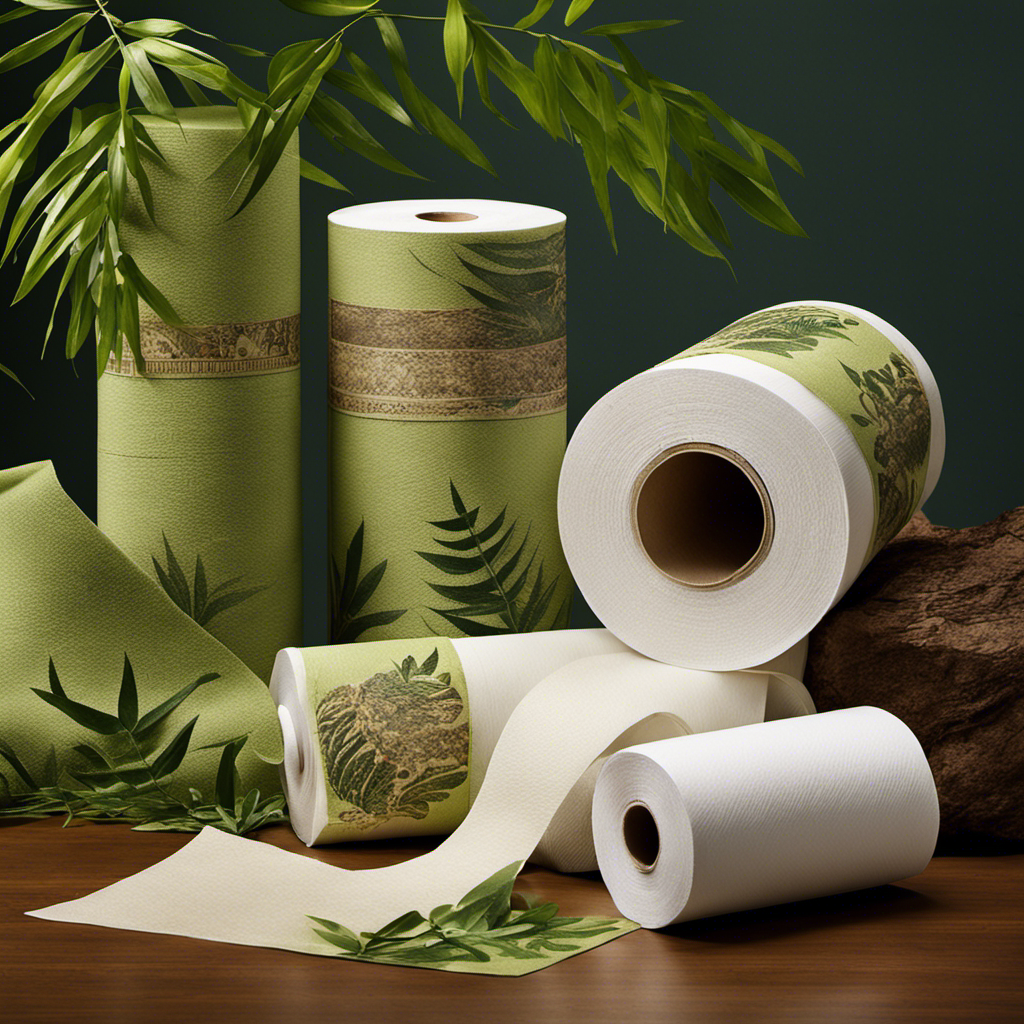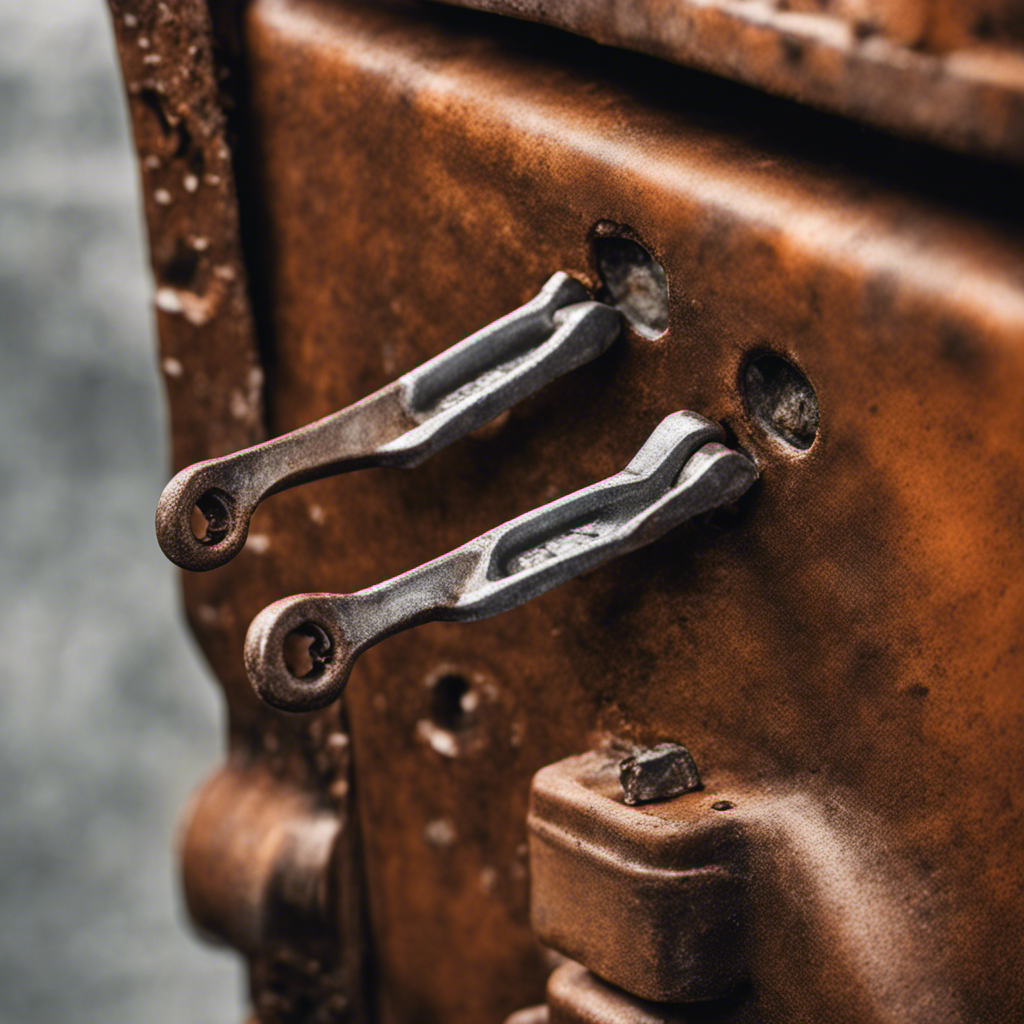Have you ever wondered about the evolution of toilet paper? It’s fascinating to think about how our methods of cleaning have changed over time.
From ancient cultures using sponges on sticks and leaves, to the introduction of fabric toilet paper for Chinese royalty, to the invention of toilet paper on a roll by Clarence and E. Irvin Scott in the 1890s.
Today, we have a variety of options, including eco-friendly bamboo toilet paper. In this article, we’ll explore the different types of toilet paper and how they reflect our changing preferences and concerns for hygiene and sustainability.
Key Takeaways
- Toilet paper has evolved over time, with various cultures using different methods for cleaning up before its invention.
- Fabric toilet paper was initially reserved for Chinese royalty during the Tang Dynasty.
- Different types of toilet paper vary in strength, cost, eco-friendliness, and comfort levels.
- Bamboo toilet paper is eco-friendly and can hold more water than traditional toilet paper.
Ancient Methods of Toilet Paper
I find it fascinating how ancient cultures used various methods like sponges on sticks and pebbles for cleaning before toilet paper was invented. These toilet paper alternatives varied across different cultural practices.
For example, the Greco-Romans used a tool called the tersorium, which was a sponge attached to a stick. They would use this to clean themselves after using the toilet. In addition, the Romans also used pessoi, which were small pebbles, for the same purpose.
Other cultures used different materials such as corn cobs, animal furs, seashells, and leaves. It’s interesting to see how creativity and resourcefulness played a role in maintaining hygiene before the invention of toilet paper.
These cultural variations highlight the ingenuity of ancient societies in finding innovative solutions to everyday needs.
Fabric Toilet Paper: A Luxury for Royalty
During the Tang Dynasty, fabric toilet paper was exclusively reserved for Chinese royalty, providing them with a luxurious and comfortable option for hygiene. Fabric toilet paper, made from soft and gentle materials, offered a superior experience compared to other alternatives of the time. It was a testament to the wealth and privilege of the royal class.
However, with the passage of time, toilet paper has evolved, and today we have various options to choose from, including bamboo toilet paper. Bamboo toilet paper has gained popularity due to its eco-friendliness and ability to hold more water. It offers a sustainable alternative to traditional toilet paper, reducing our carbon footprint.
When it comes to comparing fabric and bamboo toilet paper, both offer comfort and hygiene, but bamboo toilet paper stands out for its ecological benefits. The role of toilet paper in hygiene practices cannot be understated, as it plays a crucial role in maintaining cleanliness and promoting good health.
The Introduction of Toilet Paper on a Roll
The introduction of toilet paper on a roll revolutionized the way people cleaned up after using the bathroom, providing a more convenient and efficient method.
The invention of the toilet paper roll in the 1890s by Clarence and E. Irvin Scott marked a significant milestone in the history of toilet paper. This innovation quickly gained popularity in the early-to-mid 20th century.
Prior to the invention of the toilet paper roll, people used various materials for cleaning, including corn cobs, animal furs, seashells, and leaves. The toilet paper roll offered a more hygienic and comfortable option.
Its popularity grew as it offered a convenient way to dispense and use toilet paper. Today, the toilet paper roll remains the most widely used and preferred method for bathroom hygiene.
Exploring Different Types of Toilet Paper
One type of toilet paper is the two-ply variety, which offers durability and a softer feel. When comparing toilet paper options, it’s important to consider the strength, cost, eco-friendliness, and comfort levels. Here are three key factors to consider:
-
Cost-effectiveness: One-ply toilet paper is a more cost-effective option as it has only one layer of paper. It is lightweight and reduces the risk of drain blockage. However, it may require more quantity compared to multi-ply options.
-
Comfort and durability: Two-ply toilet paper consists of two layers, providing both durability and a softer feel. It is moderately priced and requires less quantity compared to one-ply toilet paper. This makes it a suitable choice for those looking for a balance between cost and comfort.
-
Eco-friendliness: Bamboo toilet paper is an innovative option that is eco-friendly. Bamboo is a fast-growing grass that can hold more water in proportion to its weight compared to traditional toilet paper. It helps reduce carbon footprint and offers a comfortable and sustainable alternative for environmentally conscious individuals.
Considering these factors can help you make an informed decision when comparing toilet paper options.
The Benefits of One-Ply Toilet Paper
I prefer using one-ply toilet paper because it is cost-effective and lightweight.
One-ply toilet paper offers a great cost-benefit ratio compared to other types. It is more affordable, making it an economical choice for many households. Additionally, its lightweight nature reduces the risk of drain blockage. The single layer of paper is less likely to cause clogs in the plumbing system.
While more one-ply toilet paper may be needed compared to multi-ply options, the overall cost remains lower. This makes it a practical choice for individuals who want to save money without compromising on quality.
Embracing Eco-Friendly Bamboo Toilet Paper
Using bamboo for toilet paper is a sustainable choice that helps reduce environmental impact. Bamboo is a fast-growing grass that can be harvested without killing the plant, making it a renewable resource.
Here are three reasons why bamboo toilet paper is an eco-friendly option:
-
Sustainable Sourcing: Bamboo grows rapidly and can be harvested in just a few years, unlike traditional trees that take decades to mature. This sustainable sourcing helps preserve forests and reduces deforestation, which is crucial for maintaining biodiversity and combating climate change.
-
Reduced Carbon Footprint: Bamboo has a lower carbon footprint compared to traditional toilet paper made from trees. It requires less water, fertilizer, and pesticides to grow, making it a more environmentally friendly choice.
-
Comfort and Quality: Bamboo toilet paper is soft, strong, and absorbent. It provides a comfortable experience while also being gentle on the skin. By choosing bamboo toilet paper, you can enjoy a high-quality product while making a positive impact on the environment.
Frequently Asked Questions
How Did People Clean Themselves Before Toilet Paper Was Invented?
Before toilet paper was invented, people used various methods for personal hygiene. These included tools like the tersorium and pessoi, as well as materials like corn cobs, animal furs, seashells, and leaves. Cultural practices varied across ancient civilizations.
What Were Some Alternative Materials Used as Toilet Paper Throughout History?
Throughout history, people used various alternative materials as toilet paper. These included corn cobs, animal furs, seashells, and leaves. Understanding the sustainability of different types of toilet paper is crucial for making eco-friendly choices.
When Was Fabric Toilet Paper First Introduced and Who Had Access to It?
Fabric toilet paper, a luxurious invention, first graced the royal behinds of the Tang Dynasty in China. Commoners longed for the day when they too could experience its softness and opulence.
Who Invented Toilet Paper on a Roll and When Did It Become Popular?
The invention of toilet paper on a roll is credited to Clarence and E. Irvin Scott in the 1890s. It gained popularity in the early-to-mid 20th century, becoming a convenient and widely used method of hygiene.
What Are the Different Types of Toilet Paper and How Do They Vary in Terms of Strength, Cost, and Eco-Friendliness?
Sustainable alternatives like bamboo toilet paper offer an eco-friendly and affordable option. The impact of packaging varies among brands, contributing to their environmental footprint. Understanding the strength, cost, and eco-friendliness of different types of toilet paper helps make informed choices.
Conclusion
In conclusion, the evolution of toilet paper has come a long way. From ancient methods like sponges on sticks to the introduction of toilet paper on a roll by Clarence and E. Irvin Scott. Today, we have a variety of options to choose from, each with its own benefits.
For example, bamboo toilet paper is not only eco-friendly but also soft and absorbent. Imagine a scenario where a family switches to bamboo toilet paper. They realize they are not only reducing their environmental impact but also experiencing a newfound level of comfort and satisfaction.
This example emphasizes the importance of making sustainable choices that can improve our daily lives.










